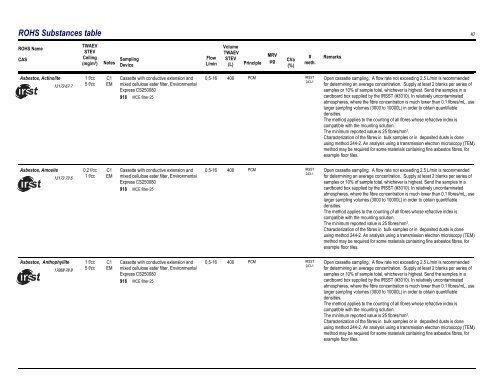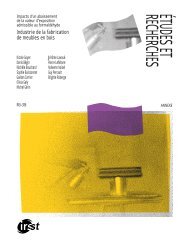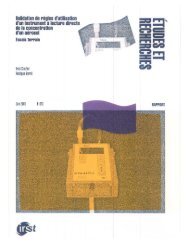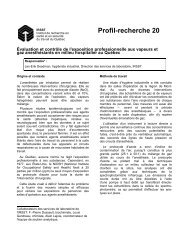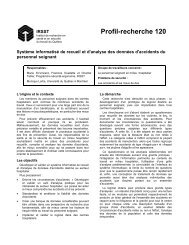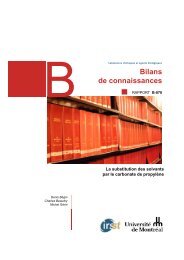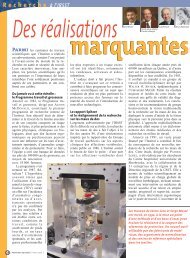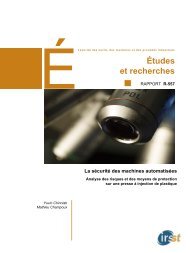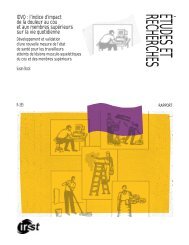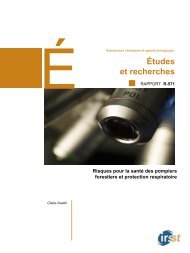Sampling Guide for Air Contaminants in the Workplace - Irsst
Sampling Guide for Air Contaminants in the Workplace - Irsst
Sampling Guide for Air Contaminants in the Workplace - Irsst
Create successful ePaper yourself
Turn your PDF publications into a flip-book with our unique Google optimized e-Paper software.
ROHS Substances table<br />
47<br />
ROHS Name<br />
CAS<br />
TWAEV<br />
STEV<br />
Ceil<strong>in</strong>g<br />
(mg/m³)<br />
Notes<br />
<strong>Sampl<strong>in</strong>g</strong><br />
Device<br />
Flow<br />
L/m<strong>in</strong><br />
Volume<br />
TWAEV<br />
STEV<br />
(L)<br />
Pr<strong>in</strong>ciple<br />
MRV<br />
µg<br />
CVa<br />
(%)<br />
#<br />
meth.<br />
Remarks<br />
Asbestos, Act<strong>in</strong>olite<br />
12172-67-7<br />
1 f/cc<br />
5 f/cc<br />
C1<br />
EM<br />
Cassette with conductive extension and<br />
mixed cellulose ester filter, Environmental<br />
Express CS250080<br />
918 MCE filter-25<br />
0,5-16 PCM<br />
400 IRSST<br />
243-1<br />
Open cassette sampl<strong>in</strong>g. A flow rate not exceed<strong>in</strong>g 2.5 L/m<strong>in</strong> is recommended<br />
<strong>for</strong> determ<strong>in</strong><strong>in</strong>g an average concentration. Supply at least 2 blanks per series of<br />
samples or 10% of sample total, whichever is highest. Send <strong>the</strong> samples <strong>in</strong> a<br />
cardboard box supplied by <strong>the</strong> IRSST (#3010). In relatively uncontam<strong>in</strong>ated<br />
atmospheres, where <strong>the</strong> fibre concentration is much lower than 0.1 fibres/mL, use<br />
larger sampl<strong>in</strong>g volumes (3000 to 10000L) <strong>in</strong> order to obta<strong>in</strong> quantifiable<br />
densities.<br />
The method applies to <strong>the</strong> count<strong>in</strong>g of all fibres whose refractive <strong>in</strong>dex is<br />
compatible with <strong>the</strong> mount<strong>in</strong>g solution.<br />
The m<strong>in</strong>imum reported value is 25 fibres/mm².<br />
Characterization of <strong>the</strong> fibres <strong>in</strong> bulk samples or <strong>in</strong> deposited dusts is done<br />
us<strong>in</strong>g method 244-2. An analysis us<strong>in</strong>g a transmission electron microscopy (TEM)<br />
method may be required <strong>for</strong> some materials conta<strong>in</strong><strong>in</strong>g f<strong>in</strong>e asbestos fibres, <strong>for</strong><br />
example floor tiles.<br />
Asbestos, Amosite<br />
12172-73-5<br />
0,2 f/cc<br />
1 f/cc<br />
C1<br />
EM<br />
Cassette with conductive extension and<br />
mixed cellulose ester filter, Environmental<br />
Express CS250080<br />
918 MCE filter-25<br />
0,5-16 PCM<br />
400 IRSST<br />
243-1<br />
Open cassette sampl<strong>in</strong>g. A flow rate not exceed<strong>in</strong>g 2.5 L/m<strong>in</strong> is recommended<br />
<strong>for</strong> determ<strong>in</strong><strong>in</strong>g an average concentration. Supply at least 2 blanks per series of<br />
samples or 10% of sample total, whichever is highest. Send <strong>the</strong> samples <strong>in</strong> a<br />
cardboard box supplied by <strong>the</strong> IRSST (#3010). In relatively uncontam<strong>in</strong>ated<br />
atmospheres, where <strong>the</strong> fibre concentration is much lower than 0.1 fibres/mL, use<br />
larger sampl<strong>in</strong>g volumes (3000 to 10000L) <strong>in</strong> order to obta<strong>in</strong> quantifiable<br />
densities.<br />
The method applies to <strong>the</strong> count<strong>in</strong>g of all fibres whose refractive <strong>in</strong>dex is<br />
compatible with <strong>the</strong> mount<strong>in</strong>g solution.<br />
The m<strong>in</strong>imum reported value is 25 fibres/mm².<br />
Characterization of <strong>the</strong> fibres <strong>in</strong> bulk samples or <strong>in</strong> deposited dusts is done<br />
us<strong>in</strong>g method 244-2. An analysis us<strong>in</strong>g a transmission electron microscopy (TEM)<br />
method may be required <strong>for</strong> some materials conta<strong>in</strong><strong>in</strong>g f<strong>in</strong>e asbestos fibres, <strong>for</strong><br />
example floor tiles.<br />
Asbestos, Anthophyllite<br />
17068-78-9<br />
1 f/cc<br />
5 f/cc<br />
C1<br />
EM<br />
Cassette with conductive extension and<br />
mixed cellulose ester filter, Environmental<br />
Express CS250080<br />
918 MCE filter-25<br />
0,5-16 400 PCM<br />
IRSST<br />
243-1<br />
Open cassette sampl<strong>in</strong>g. A flow rate not exceed<strong>in</strong>g 2.5 L/m<strong>in</strong> is recommended<br />
<strong>for</strong> determ<strong>in</strong><strong>in</strong>g an average concentration. Supply at least 2 blanks per series of<br />
samples or 10% of sample total, whichever is highest. Send <strong>the</strong> samples <strong>in</strong> a<br />
cardboard box supplied by <strong>the</strong> IRSST (#3010). In relatively uncontam<strong>in</strong>ated<br />
atmospheres, where <strong>the</strong> fibre concentration is much lower than 0.1 fibres/mL, use<br />
larger sampl<strong>in</strong>g volumes (3000 to 10000L) <strong>in</strong> order to obta<strong>in</strong> quantifiable<br />
densities.<br />
The method applies to <strong>the</strong> count<strong>in</strong>g of all fibres whose refractive <strong>in</strong>dex is<br />
compatible with <strong>the</strong> mount<strong>in</strong>g solution.<br />
The m<strong>in</strong>imum reported value is 25 fibres/mm².<br />
Characterization of <strong>the</strong> fibres <strong>in</strong> bulk samples or <strong>in</strong> deposited dusts is done<br />
us<strong>in</strong>g method 244-2. An analysis us<strong>in</strong>g a transmission electron microscopy (TEM)<br />
method may be required <strong>for</strong> some materials conta<strong>in</strong><strong>in</strong>g f<strong>in</strong>e asbestos fibres, <strong>for</strong><br />
example floor tiles.


